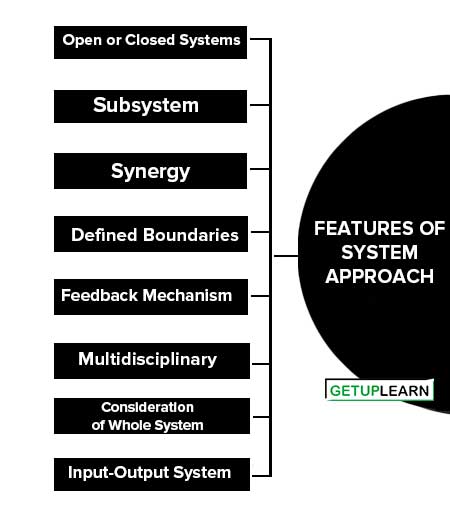Table of Contents
What is Systems Approach to Management?
A system is any set of distinct parts that interact to form a complex whole. Think of the universe. Its parts are as small as a subatomic particle and as large as galactic clusters. Each part is distinct but interacts to form the universe. An organization is also a system with parts such as employees, assets, products, resources, and information that form a complex system. Systems can be open or closed. A closed system is not affected by its environment.

For example, a chuck of iron ore is not substantially affected by its environment. An open system is a system that is affected by its environment. A simple example is a living organism, such as an animal. Most theorists treat an organization as an open system. An open system consists of three essential elements.
An organization receives resources such as equipment, natural resources, and the work of employees referred to as inputs. The inputs are transformed, called throughputs, and then yield products or services called outputs. Outputs are released into the environment.
Feedback loops are also an important feature of open systems. They provide information to the organization by connecting the outputs to the inputs. A negative feedback loop indicates a problem that should be corrected. For example, the failure of product design is indicated by the need to recall the product.
A positive feedback loop can identify outputs that have worked well. For example, a successful marketing campaign that yields high sales. Thus, feedback loops are a means of confirming success or signalling that corrections to the system need to be made.
Features of System Approach
These are the features of system approach which are explained below:
- Open or Closed Systems
- Subsystem
- Synergy
- Defined Boundaries
- Feedback Mechanism
- Multidisciplinary
- Consideration of Whole System
- Input-Output System

Open or Closed Systems
Systems may be either open or closed: An open system is one, which depends on the outside environment for survival. A closed system does not interact with the environment.
Subsystem
The full system is made up of many parts. Each of these parts is called a subsystem. A system may be a subsystem of a larger system. For example. a department is a subsystem of a plant. A plant is a subsystem of a company.
Continuous and effective interaction of sub-systems helps to attain the goals of the larger system. Thus, every sub-system is a system and has sub-systems which together make an organization a set of mutually dependent parts and their sub-parts.
Synergy
Synergy means that the whole is greater than the sum of its parts. In an organization, when different departments cooperate and interact, they become more productive. This is called synergy.
Defined Boundaries
Each system has a boundary that separates it from its environment. In the case of a closed system, the system boundary is rigid. However, in an open system, the boundary is flexible. A business organization has boundaries with many external systems like creditors, suppliers, customers, government agencies, etc. The system is inside the boundary, the environment is outside the boundary.
Feedback Mechanism
A system can adjust itself to the changing environment through the feedback mechanism. Feedback helps the system to find out and correct its mistakes.
Multidisciplinary
Management system uses information from many disciplines such as psychology, sociology, ecology, economics, mathematics, statistics, operations research, systems analysis, etc. Therefore, it is multidisciplinary in nature.
Consideration of Whole System
No part of the system can be fully studied and understood without properly understanding all of its parts. So instead of dealing separately with different parts of one organization, the manager must study the entire organization as a whole.
For example, in order to understand the working of the finance, production or marketing department, he/she must understand the company as a whole. It is because the activity of any one part of the company affects the activity of every other part.
Input-Output System
A business organization is an input-output system. Inputs consist of human, physical and financial resources obtained from the environment. These resources are converted into outputs of products and services.
Characteristics of Systems Approach
Let’s look at the characteristics of systems approach:

Interdependent Sub-Systems
An organization is a system consisting of several sub-systems. For example, in a business enterprise, production, sales and other departments and subsystems. All these sub-systems are functionally interacting and interdependent. They are used together into an organic whole through goals, authority flows, and resources flow and so on.
Whole Organization
The system approach provides a unified focus on organizational efforts. It gives managers a way of looking at the organization as a whole that is greater than the sum of its parts. The stress is laid on the integration of various sub-systems of the organization to ensure the overall effectiveness of the system.
Synergy
The output of a system is always more than the combined output of its parts. This is called the law of synergy. The parts of the system become more productive when they interact with each other than when they act in isolation.
Multi-Disciplinary
The modern theory of management is enriched by contributions from various disciplines like psychology, sociology, economics, anthropology, mathematics, operations research and so on.
Use of System Approach
The following are the use of system approach:
- The system approach provides a holistic view of the organizations and emphasizes on their adaptive nature. It increases an organization’s adaptability to environmental changes. The organization is studied as a whole and not through its parts. This enables it to adapt to the needs of the environment. Decisions are made keeping in mind the organization-environment interface.
- It analyses the system at different levels and inter-relates and integrates it into a unified set of directions. Starting from individual goals, it focuses on overall organizational goals, synthesizes the two and converges them into the global economy.
- The system approach provides a framework for the effective interaction of parts of the organization in a specific arrangement for the attainment of its goals. It does not focus on one part of the organization.
- It considers the impact of the environment on the organization and vice versa. The interaction of the external environment with the internal environment is the most significant contribution of systems theory. The system approach, thus, analyses the organization as an adaptive and dynamic entity.
- The system approach synthesizes the classical and behavioural theories into a broader framework to solve managerial problems.
Limitations of System Approach
The following are the limitations of system approach:
- Critics of this theory claim this is a theoretical approach to management. The way an organization actually works and solves problems (by applying different techniques and methods) has no appeal in the theory.
- The relationship amongst parts of the organization is emphasized but the exact nature of inter-dependence is not defined.
- The exact relationship between the internal and external environment of the organization is also not defined. For example, it specifies that a change in economic policies necessitates a change in the internal policies of the organization but what changes are required to match the changes in the economic environment is not talked about.
- The system approach fails to provide a uniform approach to management. Management practices change with changes in environmental variables. No standard set of principles applies to all types of organizations. It has added nothing new to the study of management.
Even before this approach was introduced, managerial decisions were taken keeping in mind the environmental variables. No specific decision-making techniques are offered to deal with specific problems.
- It fails to provide concepts that apply to all types of organizations. Small organizations are less adaptive to environmental variables than large organizations. The theory assumes that most organizations are big, complex and open systems. It, thus, fails to provide a unified theory.
What is a Systems Approach?
A system is any set of distinct parts that interact to form a complex whole. Think of the universe. Its parts are as small as a subatomic particle and as large as galactic clusters. Each part is distinct but interacts to form the universe. An organization is also a system with parts such as employees, assets, products, resources, and information that form a complex system. Systems can be open or closed. A closed system is not affected by its environment.
What are the features of system approach?
The following are the features of system approach:
1. Open or Closed Systems
2. Subsystem
3. Synergy
4. Defined Boundaries
5. Feedback Mechanism
6. Multidisciplinary
7. Consideration of the Whole System
8. Input-Output System.














